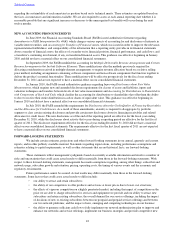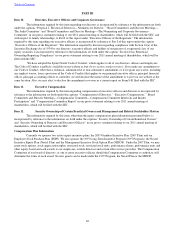Sprint - Nextel 2010 Annual Report Download - page 46
Download and view the complete annual report
Please find page 46 of the 2010 Sprint - Nextel annual report below. You can navigate through the pages in the report by either clicking on the pages listed below, or by using the keyword search tool below to find specific information within the annual report.
currencies, and equity prices. The risk inherent in our market risk sensitive instruments and positions is the potential loss
arising from adverse changes in those factors.
Interest Rate Risk
The communications industry is a capital intensive, technology driven business. We are subject to interest rate risk
primarily associated with our borrowings. Interest rate risk is the risk that changes in interest rates could adversely affect
earnings and cash flows. Specific interest rate risk includes: the risk of increasing interest rates on floating-rate debt and the
risk of increasing interest rates for planned new fixed rate long-term financings or refinancings.
About 86% of our debt as of December 31, 2010 was fixed-rate debt. While changes in interest rates impact the fair
value of this debt, there is no impact to earnings and cash flows because we intend to hold these obligations to maturity unless
market and other conditions are favorable.
We perform interest rate sensitivity analyses on our variable rate debt. These analyses indicate that a one percentage
point change in interest rates would have an annual pre-tax impact of $27 million on our consolidated statements of operations
and cash flows for the year ended December 31, 2010. We also perform a sensitivity analysis on the fair market value of our
outstanding debt. A 10% decline in market interest rates would cause a $751 million increase in the fair market value of our
debt to $20.8 billion.
Foreign Currency Risk
We also enter into forward contracts and options in foreign currencies to reduce the impact of changes in foreign
exchange rates. Our foreign exchange risk management program focuses on reducing transaction exposure to optimize
consolidated cash flow. We use foreign currency derivatives to hedge our foreign currency exposure related to settlement of
international telecommunications access charges and the operation of our international subsidiaries. The dollar equivalent of
our net foreign currency payables from international settlements was $7 million and the net foreign currency receivables from
international operations were $4 million as of December 31, 2010. The potential immediate pre-tax loss to us that would result
from a hypothetical 10% change in foreign currency exchange rates based on these positions would be insignificant.
Equity Risk
We are exposed to market risk as it relates to changes in the market value of our investments. We invest in equity
instruments of public companies for operational and strategic business purposes. These securities are subject to significant
fluctuations in fair market value due to volatility of the stock market and industries in which the companies operate. These
securities, which are classified in investments on the consolidated balance sheets, primarily include equity method investments,
such as our investment in Clearwire and available-for-sale securities.
In certain business transactions, we are granted warrants to purchase the securities of other companies at fixed rates.
These warrants are supplemental to the terms of the business transaction and are not designated as hedging instruments.
Item 8. Financial Statements and Supplementary Data
The consolidated financial statements required by this item begin on page F-1 of this annual report on Form 10-K and
are incorporated herein by reference. The financial statements of Clearwire, as required under Regulation S-X, are filed
pursuant to Item 15 of this annual report on Form 10-K and incorporated herein by reference.
Item 9. Changes in and Disagreements with Accountants on Accounting and Financial Disclosure
None.
Item 9A. Controls and Procedures
Evaluation of Disclosure Controls and Procedures
Disclosure controls are procedures that are designed with the objective of ensuring that information required to be
disclosed in our reports under the Securities Exchange Act of 1934, such as this Form 10-K, is reported in accordance with the
SEC's rules. Disclosure controls are also designed with the objective of ensuring that such information is accumulated and
communicated to management, including the Chief Executive Officer and Chief Financial Officer, to allow timely decisions
regarding required disclosure.
In connection with the preparation of this Form 10-K, under the supervision and with the participation of our
management, including our Chief Executive Officer and Chief Financial Officer, we carried out an evaluation of the
effectiveness of the design and operation of our disclosure controls and procedures. Based on this evaluation, the Chief
Executive Officer and Chief Financial Officer concluded that the design and operation of the disclosure controls and procedures
were effective as of December 31, 2010 in providing reasonable assurance that information required to be disclosed in reports
we file or submit under the Securities Exchange Act of 1934 is accumulated and communicated to management, including the
Chief Executive Officer and Chief Financial Officer, to allow timely decisions regarding required disclosure and in providing
reasonable assurance that the information is recorded, processed, summarized and reported within the time periods specified in
Table of Contents
44
























